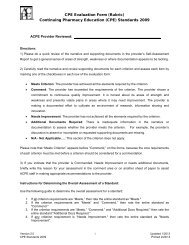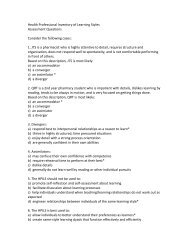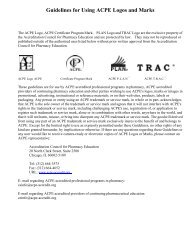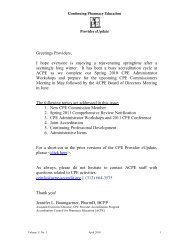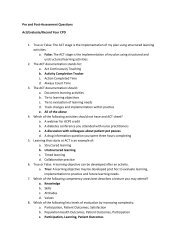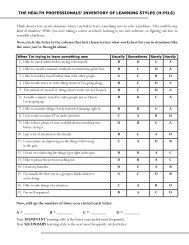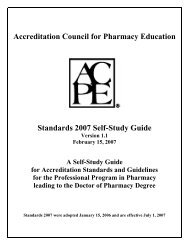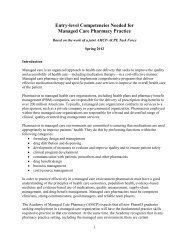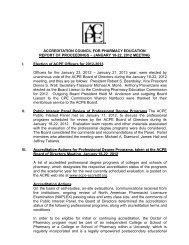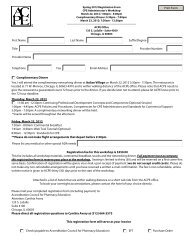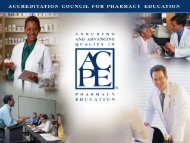Health Professionals' Inventory of Learning Styles (H-PILS) g y ...
Health Professionals' Inventory of Learning Styles (H-PILS) g y ...
Health Professionals' Inventory of Learning Styles (H-PILS) g y ...
- No tags were found...
Create successful ePaper yourself
Turn your PDF publications into a flip-book with our unique Google optimized e-Paper software.
4/12/2010Objectives<strong>Health</strong> Pr<strong>of</strong>essionals’ <strong>Inventory</strong><strong>of</strong> <strong>Learning</strong> <strong>Styles</strong> (H‐<strong>PILS</strong>)Zubin Austin PhDAssociate Dean – AcademicUniversity <strong>of</strong> Toronto, CanadaUpon completion <strong>of</strong> this session, you will beable to:a) Discuss the role <strong>of</strong> self‐reflection in CPDb) Apply learning styles theory to facilitate selfreflectionc) Use the H‐<strong>PILS</strong> to support CPDI. Self reflection in CPD• CPD cycle begins with self‐reflection• Essential skill to support identification <strong>of</strong>learning needs• Essential ilpropensity to facilitate on‐goinglearning• Rarely taught or evaluated in a formal way• Not necessarily a natural process for manyWhat is self‐reflection?• Purposeful and directed examination <strong>of</strong> one’sown behaviours, thoughts, and beliefs using avariety <strong>of</strong> different sources <strong>of</strong> evidence andcriteria• Analytical, continuous process• Frequently aimed at quality improvement orprocess refinementWhy is self‐reflection important?• Throughout school, we can rely upon externalstandards and assessments to direct ourdevelopment• Pr<strong>of</strong>essional work is complex, individual, andhighly contextual: external standards may bedifficult to find or apply• In the absence <strong>of</strong> continuous self‐reflection,complacency developsSelf reflection and self assessment• Require on‐going discipline and structure• Require honesty and openness• Documentation• “We don’t know what we don’t know”: needto triangulate and solicit information from avariety <strong>of</strong> sources, but integrate thisinformation ourselves1
4/12/2010How good are we at it?• Accuracy <strong>of</strong> self‐reflection and self‐assessmentvaries widely• Over‐estimation <strong>of</strong> self common in those withlowest abilities• Under‐estimation <strong>of</strong> self common in thosewith highest abilities• A knowledge base• A skill set• A propensitySelf reflectionII. Role <strong>of</strong> <strong>Learning</strong> <strong>Styles</strong> Theory inSelf ReflectionHow do we learn?‐ Behavioural approaches emphasize rewardsand punishments‐ Cognitive approaches emphasize supremacy<strong>of</strong> thought and reason‐ Developmental approaches emphasizeimportance <strong>of</strong> age, stage, and time‐ Psychoanalytic approaches help make theunconscious conscious<strong>Learning</strong> <strong>Styles</strong> Theory• Piaget: children are born different• Eysenk: the biological basis <strong>of</strong> learning• Kolb: learning styles<strong>Learning</strong> and Memory• Working memory• Short‐term memory• Long‐term memory• Deep learning• Superficial learningHow do we learn?• Intersection <strong>of</strong> two interdependent processes:‐ How we take in information from the outsideworld‐ What we do with ihthat information i once we’vetaken it all in2
4/12/2010<strong>Learning</strong> <strong>Styles</strong>DivergersAccommodatorDOINGConvergerACTINGREFLECTINGDivergerWATCHINGAssimilator• “Let’s just all get along together, okay?”• Value harmony and relationships overobjective outcomes <strong>of</strong> success• May not necessarily grasp details or timelines• Are acutely sensitive to environment andnegative feedback• Enjoy working with others for the purpose <strong>of</strong>building relationships –this is how learningreally occursAssimilatorsConvergers• “Lack <strong>of</strong> planning on your part is no reason foran emergency on my part”• Organized, detailed oriented, learn by readingand lectures: “model” students• Require rehearsal time, advanced notice,structure and organization• May confuse others’ confidence forcompetence• Usually hardest on themselves• “Relax everyone, I’m here to help”• Tend to be decisive, leader‐oriented,competitive individuals• Less concerned with details, more withoutcomes• Less concerned with personal feelings thanwith success• May confuse their own confidence withcompetenceAccommodators• “Are we there yet?”• Value efficiency, sometimes at the price <strong>of</strong>effectiveness• Require or want little direction or feedback• Not burdened dby need for perfection or detail• Like to get things done• Grow impatient with the abstract and thetheoretical• Dislike excessive feedback, talking, orunnecessary interactionIII. H‐<strong>PILS</strong>• <strong>Health</strong> Pr<strong>of</strong>essionals’ <strong>Inventory</strong> <strong>of</strong> <strong>Learning</strong><strong>Styles</strong>• Tool developed to assist health pr<strong>of</strong>essionalsidentify their own learning style to helpfacilitate self‐reflection• Initially developed for pharmacists, now usedin a variety <strong>of</strong> different heath pr<strong>of</strong>essions andinterpr<strong>of</strong>essional settings3
4/12/2010Using the H<strong>PILS</strong>• Self‐reflection may not come easily or naturally toeveryone• CPD requires individuals to assume personalresponsibility for self‐identification <strong>of</strong> learningneeds and gaps• Getting started can be difficult because we don’tknow what we don’t know• Understanding ourselves as learners is a criticalfirst step in understanding our own learningneedsUsing the H<strong>PILS</strong>• H<strong>PILS</strong> provides us with insight into who we areas learners: what motivates us, frustrates us,inspires us, and disengages us• Understanding and articulating these factorscan help direct the type <strong>of</strong> learning that maybe most motivating and meaningful for us• As an increasing array <strong>of</strong> CE resources becomeavailable, understanding what may be mostbeneficial is criticalLimitations <strong>of</strong> the H<strong>PILS</strong>• <strong>Inventory</strong> approach produces acceptablereliability and validity, but not able to“diagnose” learning styles• <strong>Learning</strong> style is not like blood type: it is morefluid and flexible• Still, may be useful in prompting reflectionand dialogue about our own assumptionsabout learning as teachers, students, andpractitionersIV. Using H<strong>PILS</strong> in CPD• Goal is to facilitate self‐reflection• While H<strong>PILS</strong> does not addresscontent/knowledge domain learning needsand gaps, it can be useful in identifyinglearning process needsHow to use H<strong>PILS</strong>• To initiate dialogue, discussion, and reflectionon the process <strong>of</strong> learning• To provide a vocabulary for discussing learningneeds• To provide a skill set for self‐reflecting onlearningHow NOT to use H<strong>PILS</strong>• To stereotype and pigeon‐hole people• To make statements/claims or assumptionsregarding an individual’s abilities or suitabilityfor a position/role• To engineer relationships between people <strong>of</strong>the same learning style4
4/12/2010Presenting the H<strong>PILS</strong>• A tool for self reflection• Particularly useful for preceptors/mentors andstudents, to help understand when thingswork well – and not so well• A vehicle for understanding differences inapproaches to learning, work, life, etc.• A fun and interactive way <strong>of</strong> thinking aboutand discussing learningV. Applications <strong>of</strong> H<strong>PILS</strong>• Student/preceptor relationships• Workplaces• Interpr<strong>of</strong>essional settings• CPDSummary• Self‐reflection is integral to the CPD process• H<strong>PILS</strong> may provide a vehicle for discussing andreflecting upon one’s own processes forlearning• By providing a vocabulary to describe learningprocesses, H<strong>PILS</strong> can be part <strong>of</strong> a toolkit forCPD providers, educators, and othersinterested in personal and pr<strong>of</strong>essionaldevelopmentAbout H<strong>PILS</strong>• H<strong>PILS</strong> was developed by Zubin Austin at theFaculty <strong>of</strong> Pharmacy, University <strong>of</strong> Toronto.H<strong>PILS</strong> may be used by educators, withpermission <strong>of</strong> the developer, atzubin.austin@utoronto.ca5



